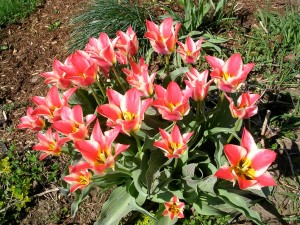Learn about tulips, including how to plant and grow them.
Listen to podcast:
How to Grow: Tulips 
Tulipa spp and hybrids
Other Name
NA
Sun Requirements
full sun, part sun
Bloom Period and Seasonal Color
Spring to early summer in a wide range of flower shapes and almost every color of the rainbow
Mature Height x Spread
4 to 24 inches x 6 to 8 inches
Added Benefits
attracts beneficials
Tulips are the standard bearer for spring flowering bulbs. They are a vast group with a variety of plant sizes, flower shapes and colors. Sizes range from the diminutive species tulips to the tall Darwin varieties. Colors can be a deep purple, almost black, to the most pristine white, in single or double petals. The petals can also be curved, frilly and striped with different colors. By growing early, mid and late season varieties you can extend the tulip flowering season for weeks. Most may need more care than daffodils to keep blooming, but the show they put on is worth the effort. I’ve particularly have become found of the species tulips for their more wildflower-like appearance and low maintenance.
Where, When and How to Plant
Purchase bulbs in fall from your local garden center and plant when you would other spring flowering bulbs. Plant tulips in groups at a depth 3 times the diameter of the bulb and spaced 3 to 4 inches apart. Plant bulbs in a full to part sun location on well-drained soil with a small handful of a bulb fertilizer in each hole.
Growing Tips
Fertilize tulip bulbs in fall or early spring when they first start growing. Keep the soil evenly moist, but not over watered, to prevent the bulbs from rotting. Deadhead spent flowers, but allow the foliage to naturally yellow and die to rejuvenate the bulbs.
Regional Advice and Care
Most tulip types, except species tulips, will stop flowering after a period of a few years. If your tulips are sending up just leaves or the flowers are getting fewer and smaller each spring, divide the bulbs. After the leaves have yellowed, dig up the bulbs and separate the small bulblets off from the mother bulb. Replant all the bulbs with a small handful of fertilizer. Keep mice, voles, and chipmunks from eating the bulbs by placing crushed oyster shells or crushed seashells in the planting hole or planting the bulbs in a wire cage underground. Spray deer repellent to thwart deer from eating the flowers.
Companion Planting and Design
Tulips can be grown in large groups of all one color or multiple colors for an overwhelming, botanic garden-like display. They also look good mixed with other perennials and shrubs, such as catmint, peonies, iris, forsythia, and daphne. Plant them near perennials with lots of foliage, such as peonies and daylilies, to hide the yellowing tulip foliage in late spring. Tulips also make excellent cut flowers.
Try These
Plant species tulips, such as ‘Lilac Wonder’ and ‘Lady Jane’, for a low growing tulip that will not only come back every year and flower, but will slowly spread. For the traditional varieties, try the ‘Darwin’, and ‘Triumph’ types with their tall stems, colorful flowers that are great for cutting. Lily-flowered tulips have curved, lily-leaves petals. ‘Angelique’ is a popular peony-flowered tulip with frilly, pink, double blossoms. ‘Parrot’ tulips have serrated-edged petals in a broad range of colors.
Excerpted from my book, New England Getting Started Garden Guide.
Podcast Transcript
As the beautiful colors of autumn spread across the countryside, today I’m going to talk about tulips! Originally from Turkey and used for medicinal purposes, the tulip has become one of the most popular spring flowering bulbs in the world. In the 1600s, tulipmania hit Europe where people spent their entire life savings to buy an individual bulb. The tulip craze has waned, but I’m still crazy about growing them.
craze has waned, but I’m still crazy about growing them.
Plant tulips now in groups. Mass plant beds of all one color tulip or mixed colors. Consider unusually shaped hybrids such as the parrot, lily, and fringed tulips. I particularly like the species tulips. They are lower growing than hybrids, but have colorful, cup-shaped flowers, and more reliably come back each year compared to hybrids.
If you have limited planting space, try layering tulips with other bulbs. In well drained, loose soil, dig a hole and plant tulip bulbs about 5- to 6- inches deep. Barely cover bulbs with soil and place crocus bulbs on top of them planted 3- to 4-inches deep. Cover these bulbs and plant small bulbs such as snow drops or scilla a couple inches deep. Water well and enjoy the spring crescendo of bulbs starting with the small snow drops and ending with your tulips.
Now for this week’s tip, don’t dig all your root crops now. Leave some for a winter harvest. They’ll taste even sweeter. Cover beds in November with a 4- to 6-inch layer of hay or straw to protect roots from freezing and harvest all winter long.


